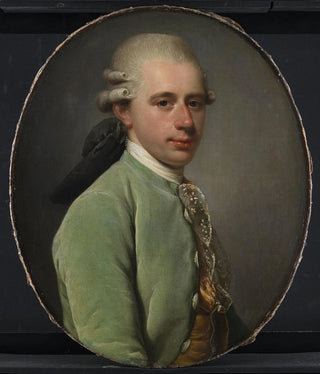Art print | The Postmaster General Frederik Hauch in his youth - Jens Juel


View from behind

Frame (optional)
In the panorama of 18th-century Danish art, the art print "The Postmaster Frederik Hauch in His Youth" by Jens Juel stands out for its elegance and psychological depth. This painting, which captures a fleeting moment in the life of an influential man, immerses us in the intimacy of a character who, although already in a position of power, retains an aura of youth and promise. Frederik Hauch's penetrating gaze, accompanied by a thoughtful posture, evokes not only his status but also the aspirations and challenges of a rapidly changing era. Through this work, Juel invites us to explore the subtleties of human personality while revealing the historical context that shapes this individual.
Style and uniqueness of the work
Jens Juel's style is characterized by a remarkable mastery of chiaroscuro and meticulous attention to detail, which give his portraits an almost lifelike dimension. In "The Postmaster Frederik Hauch in His Youth," the artist uses delicate nuances to depict the texture of clothing and facial features, creating an atmosphere of truth and authenticity. The carefully orchestrated light highlights the contours of the face and emphasizes Hauch's reflective expression, offering the viewer a glimpse into his inner world. This portrait is not limited to a simple representation; it is an open window into the soul of the subject, revealing complex emotions and rare psychological depth. The composition, balanced and harmonious, demonstrates Juel's skill in capturing the very essence of his models while framing their image within a rich and evocative historical context.
The artist and his influence
Jens Juel, an emblematic figure of Danish painting, established himself as one of the most appreciated portraitists of his time. Born in 1745, he was trained in Europe's major artistic centers, notably in Paris, where he was influenced by the masters of classical portraiture. His return to Denmark marked the beginning of a prolific career, during which he created numerous portraits of influential personalities, thus contributing to shaping the artistic identity of his country.

Matte finish

View from behind

Frame (optional)
In the panorama of 18th-century Danish art, the art print "The Postmaster Frederik Hauch in His Youth" by Jens Juel stands out for its elegance and psychological depth. This painting, which captures a fleeting moment in the life of an influential man, immerses us in the intimacy of a character who, although already in a position of power, retains an aura of youth and promise. Frederik Hauch's penetrating gaze, accompanied by a thoughtful posture, evokes not only his status but also the aspirations and challenges of a rapidly changing era. Through this work, Juel invites us to explore the subtleties of human personality while revealing the historical context that shapes this individual.
Style and uniqueness of the work
Jens Juel's style is characterized by a remarkable mastery of chiaroscuro and meticulous attention to detail, which give his portraits an almost lifelike dimension. In "The Postmaster Frederik Hauch in His Youth," the artist uses delicate nuances to depict the texture of clothing and facial features, creating an atmosphere of truth and authenticity. The carefully orchestrated light highlights the contours of the face and emphasizes Hauch's reflective expression, offering the viewer a glimpse into his inner world. This portrait is not limited to a simple representation; it is an open window into the soul of the subject, revealing complex emotions and rare psychological depth. The composition, balanced and harmonious, demonstrates Juel's skill in capturing the very essence of his models while framing their image within a rich and evocative historical context.
The artist and his influence
Jens Juel, an emblematic figure of Danish painting, established himself as one of the most appreciated portraitists of his time. Born in 1745, he was trained in Europe's major artistic centers, notably in Paris, where he was influenced by the masters of classical portraiture. His return to Denmark marked the beginning of a prolific career, during which he created numerous portraits of influential personalities, thus contributing to shaping the artistic identity of his country.






